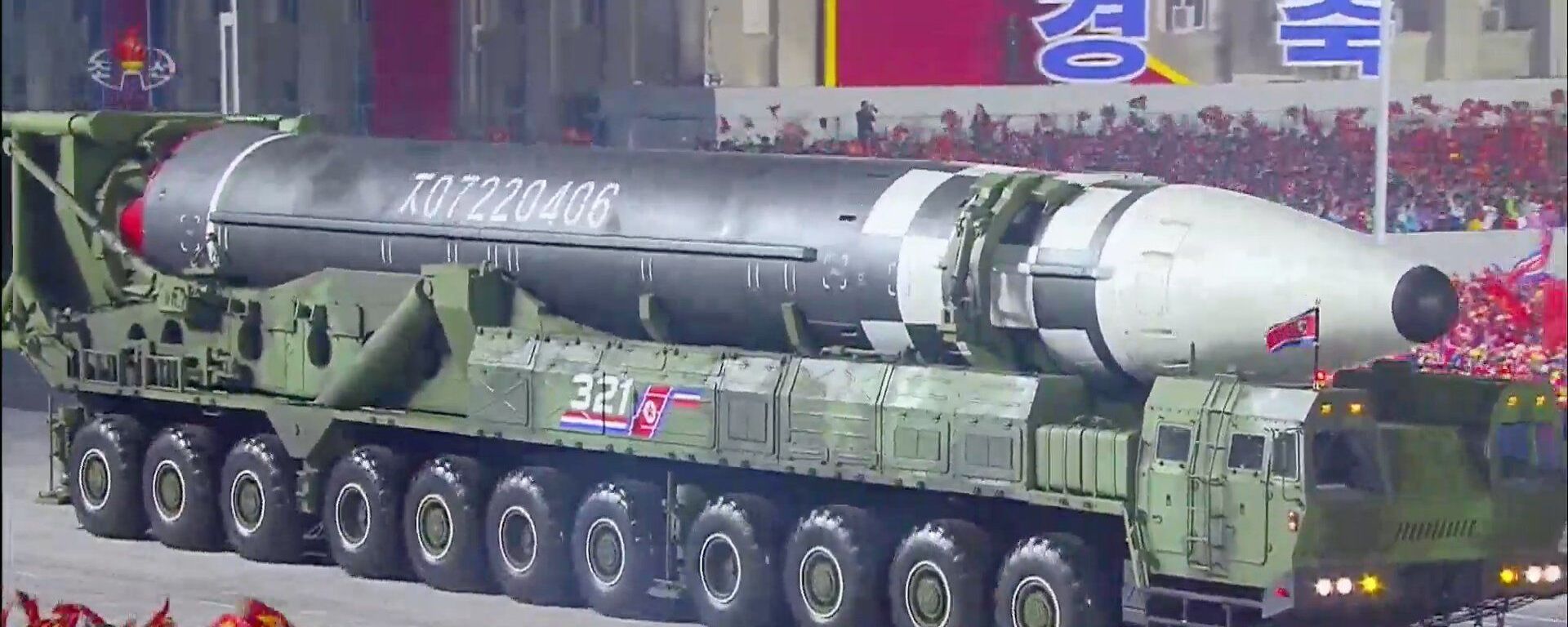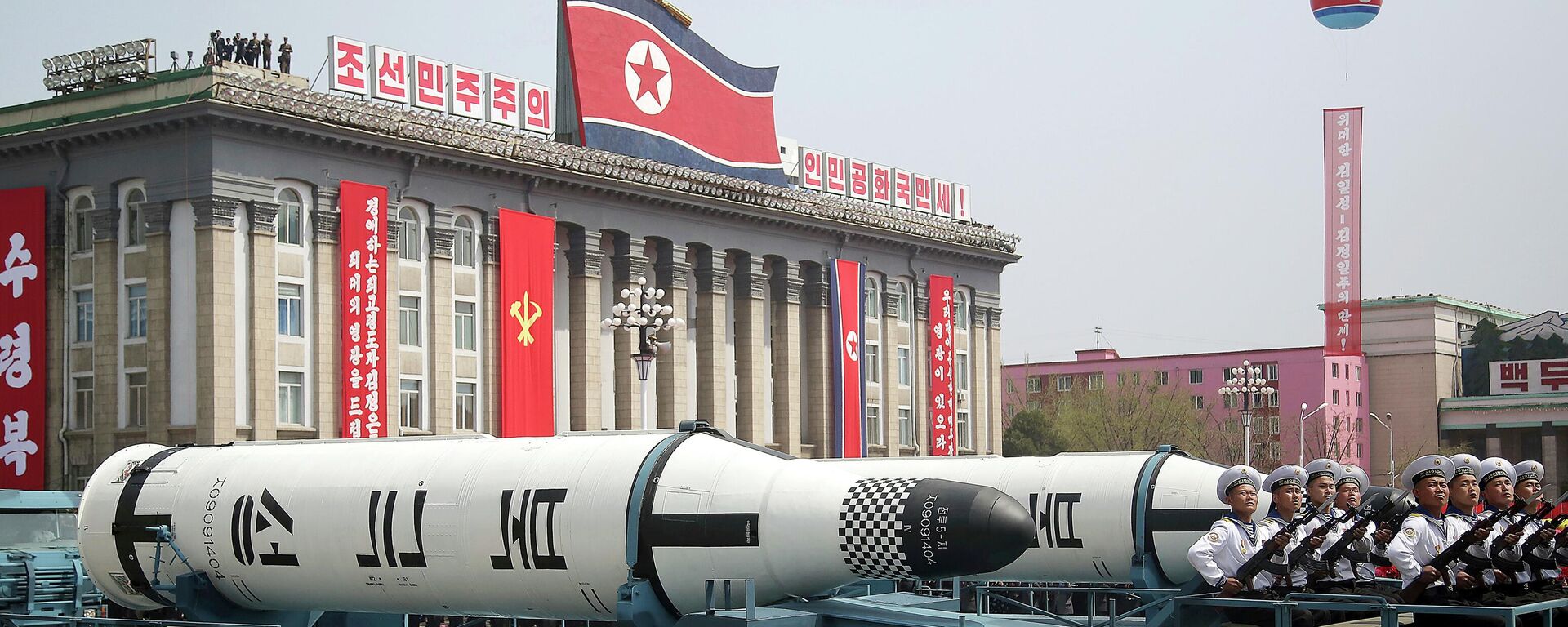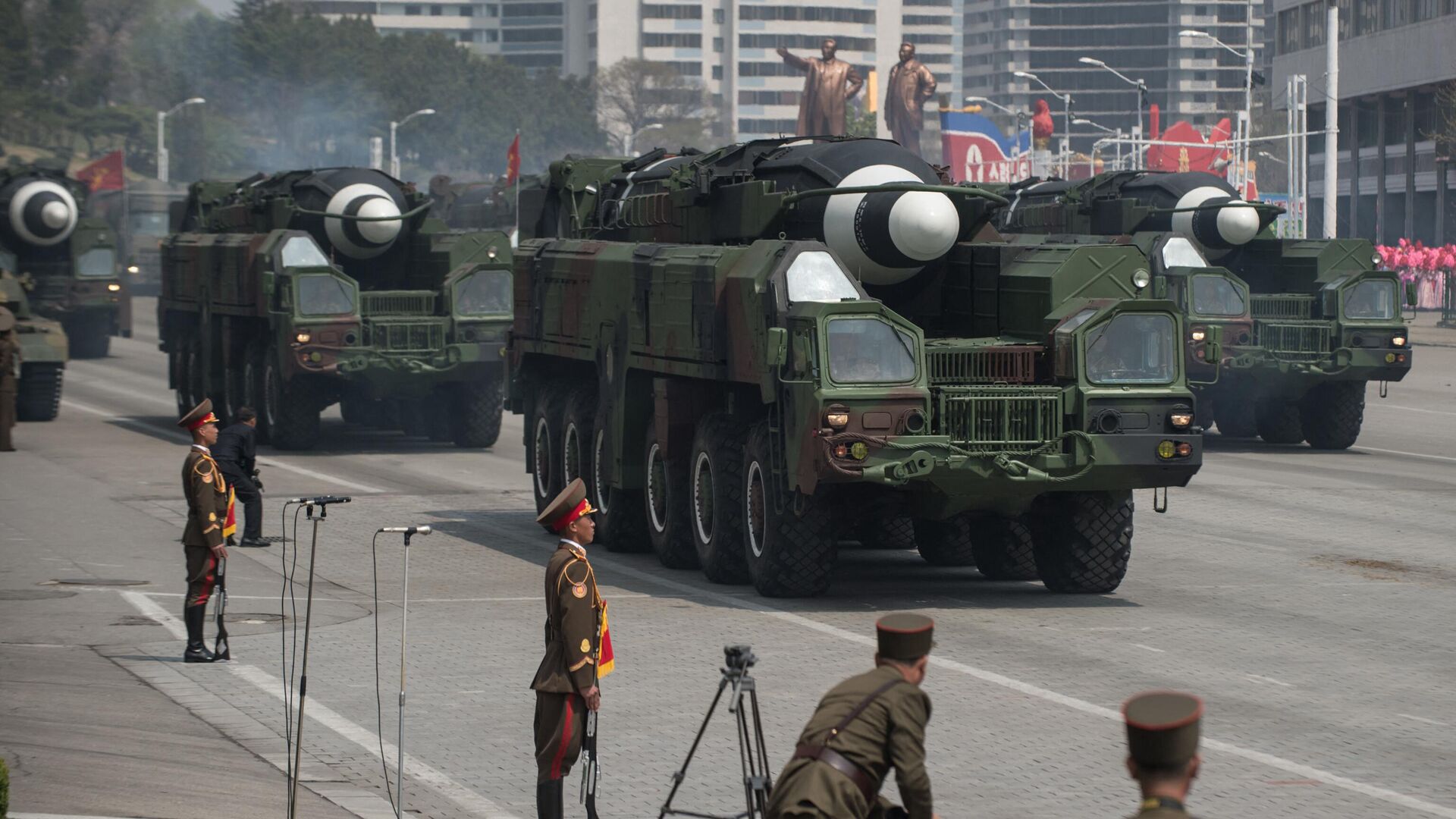https://sputnikglobe.com/20230218/monster-missile-does-north-korea-have-icbms-capable-of-reaching-us--1107575437.html
‘Monster Missile’: Does North Korea Have ICBMs Capable of Reaching US?
‘Monster Missile’: Does North Korea Have ICBMs Capable of Reaching US?
Sputnik International
North Korea, which in 2022 test¬-launched more missiles, including ballistic ones, than any other year on record, shows determination to go ahead with such activity for months to come.
2023-02-18T14:37+0000
2023-02-18T14:37+0000
2023-09-18T13:36+0000
sputnik explains
icbm
test
army
military
north korea
https://cdn1.img.sputnikglobe.com/img/07e7/02/12/1107575946_0:160:3073:1888_1920x0_80_0_0_ed70d69809286752fe90259d8d1f813c.jpg
The ballistic missile launched by the DPRK toward the Sea of Japan on February 18 reportedly had a range of 14,000 km (over 8,000 miles), which means it is capable of reaching the continental US, media has cited Japanese military sources as saying. The US command, however, insisted that the missile didn't pose a direct threat to Washington and its allies.This comes after a US newspaper claimed that Pyongyang appears to possess enough intercontinental ballistic missiles (ICBMs) to overwhelm US midcourse air defenses on the West Coast. So does North Korea really have an ICBM with a range to hit the mainland of the US? Sputnik explores.What ICBMs Does North Korea Have?Pyongyang keeps mum on everything that pertains to its ICBMs and their performance characteristics. According to Japanese media reports, there are at least eight types of ICBMs currently in service in the North Korean army:Does Pyongyang Possess ICBMs That Can Reach US?Given that the distance from North Korea to the United States is about 10,367 km (6,640 miles), it seems that it is the Hwasong-14, along with the Hwasong-15 and Hwasong-17, which can reach the continental United States. Over the past several years, the North has conducted an array of tests of the above-mentioned ICBMs, with some of them ending with failure. The country’s state-run media especially covered a test of the Hwasong-17, which is reportedly more sophisticated than the Hwasong-15 and the Hwasong-14.The official KCNA news agency reported that during the March 2022 test, the Hwasong-17 flew 1,090 km (681 miles) at a maximum altitude of 6,248.5 km (3,905 miles) and hit a target in the Sea of Japan. The ICBM was reportedly in the air for 67.5 minutes.Its predecessor, the Hwasong-15, which was first tested back in November 2017, reached an altitude of about 4,475 km (2,780 miles) and covered 950 km (590 miles) over 53 minutes.Has Hwasong-17 Ever Been on Display?Earlier this month, North Korea reportedly rolled a host of Hwasong-17 ICBMs during a military nighttime parade in Pyongyang to mark 75 years since the establishment of the country’s armed forces.This was confirmed by the London-based International Institute for Strategic Studies defense expert Joseph Dempsey, who tweeted that North Korea’s largest-yet Hwasong-17 ICBMs were on display during the parade.“Following the apparent Hwasong-17 ICBM pairs are four unidentified but apparently similarly sized canisterized systems," he added without elaborating.The Hwasong-17 was for the first time seen at a military parade to mark the 75th anniversary of the founding of North Korea’s ruling Workers’ Party in October 2020, with analysts noting it looked "considerably larger" than the Hwasong-15.The weapon was showcased for a second time at a defense exhibition in Pyongyang in October 2021. Examining photos of the exhibit, analysts suggested that the official designation of the ICBM was most likely Hwasong-17.What Are Hwasong-17's Characteristics?The Hwasong-17 is believed to be the largest ICBM that has ever been developed and is potentially able to deliver a nuclear warhead to anywhere in the US. Some analysts don’t mince words when describing the weapon as a “monster missile”.The diameter of the 27-meter-long ICBM is estimated to be between 2.4 meters and 2.5 meters, and its total mass, when fully fuelled, is probably somewhere between 80,000 and 110,000 kg (176,000 and 242,500 pounds, respectively), according to a US media outlet.Unlike its predecessors, the Hwasong-17 also might have the capability of carrying the so-called multiple re-entry vehicles (MRVs), potentially allowing a single missile to drop nuclear warheads on different targets.The Hwasong-17 is thought to be a two-stage, liquid-fuelled road-mobile ICBM carried by a 22-wheeled transporter erector launcher (TEL) vehicle.Did Pyongyang Conduct New Test of Hwasong-17 on Saturday?Even though Japanese defense sources claimed the North Korean missile that was test-launched on February 18 has the range to reach the continental US, Pyongyang has remained tightlipped on the matter and it remains unclear whether the Saturday launch was that of the Hwasong-17.Meanwhile, a Japanese broadcaster reported that Japan’s Defense Ministry assumes Pyongyang may have launched an ICBM along a so-called lofted trajectory. Another Japanese media outlet claimed that the missile was flying for 66 minutes, covering 900 kilometers (560 miles) with a maximum altitude of 5,700 kilometers (3,500 miles).Unlike a depressed trajectory when an ICBM is launched at a smaller angle from the Earth's surface, a lofted trajectory stipulates that an ICBM flies at a larger angle and arcs high above our planet's surface.
https://sputnikglobe.com/20230210/what-is-pyongyangs-possible-new-icbm-that-was-paraded-to-mark-the-dprks-army-anniversary-1107312080.html
https://sputnikglobe.com/20221105/north-korea-reportedly-launches-4-short-range-ballistic-missiles-1103809902.html
north korea
Sputnik International
feedback@sputniknews.com
+74956456601
MIA „Rosiya Segodnya“
2023
Oleg Burunov
https://cdn1.img.sputnikglobe.com/img/07e4/09/0b/1080424846_0:0:2048:2048_100x100_80_0_0_3d7b461f8a98586fa3fe739930816aea.jpg
Oleg Burunov
https://cdn1.img.sputnikglobe.com/img/07e4/09/0b/1080424846_0:0:2048:2048_100x100_80_0_0_3d7b461f8a98586fa3fe739930816aea.jpg
News
en_EN
Sputnik International
feedback@sputniknews.com
+74956456601
MIA „Rosiya Segodnya“
Sputnik International
feedback@sputniknews.com
+74956456601
MIA „Rosiya Segodnya“
Oleg Burunov
https://cdn1.img.sputnikglobe.com/img/07e4/09/0b/1080424846_0:0:2048:2048_100x100_80_0_0_3d7b461f8a98586fa3fe739930816aea.jpg
norh korea's hwasong-17 icbm, north korea's tests of icbms, hwasong-17's performance characteristics, north korean icbms' range
norh korea's hwasong-17 icbm, north korea's tests of icbms, hwasong-17's performance characteristics, north korean icbms' range
‘Monster Missile’: Does North Korea Have ICBMs Capable of Reaching US?
14:37 GMT 18.02.2023 (Updated: 13:36 GMT 18.09.2023) North Korea test-launched more missiles, including ballistics, in 2022 than any other year on record, showing determination to go ahead with such activity for months to come.
The ballistic missile launched by the DPRK toward the Sea of Japan on February 18 reportedly had a range of 14,000 km (over 8,000 miles), which means it is capable of reaching the continental US, media has cited Japanese military sources as saying.
The US command, however, insisted that the missile didn't pose a direct threat to Washington and its allies.
This comes after a US newspaper claimed that Pyongyang appears to possess enough
intercontinental ballistic missiles (ICBMs) to overwhelm US midcourse air defenses on the West Coast.
So does North Korea really have an ICBM with a range to hit the mainland of the US? Sputnik explores.
What ICBMs Does North Korea Have?
Pyongyang keeps mum on everything that pertains to its ICBMs and their performance characteristics. According to Japanese media reports, there are at least eight types of ICBMs currently in service in the North Korean army:
Nodong, with an operational range of 1,500 km (930 miles)
Pukduksong-3, with an operational range of 1,900 km (1,180 miles)
Pukduksong-2, with an operational range of 2,000 km (1,240 miles)
Musudan, with an operational range of 4,000 km (2,480 miles)
Hwasong-12, with an operational range of 4,500 km (2,790 miles)
Hwasong-14, with an operational range of 10,400 km (6,460 miles)
Hwasong-15, with an operational range of 13,000 km (8,000 miles)
Hwasong-17, with an operational range of 15,000 km (9,320 miles) and more.

10 February 2023, 13:29 GMT
Does Pyongyang Possess ICBMs That Can Reach US?
Given that the distance from North Korea to the United States is about 10,367 km (6,640 miles), it seems that it is the Hwasong-14, along with the Hwasong-15 and Hwasong-17, which can reach the continental United States. Over the past several years, the North has conducted an array of tests of the above-mentioned ICBMs, with some of them ending with failure. The country’s state-run media especially covered a test of the Hwasong-17, which is reportedly more sophisticated than the Hwasong-15 and the Hwasong-14.
The official KCNA news agency reported that during the March 2022 test, the Hwasong-17 flew 1,090 km (681 miles) at a maximum altitude of 6,248.5 km (3,905 miles) and hit a target in the Sea of Japan. The ICBM was reportedly in the air for 67.5 minutes.
Its predecessor, the Hwasong-15, which was first tested back in November 2017, reached an altitude of about 4,475 km (2,780 miles) and covered 950 km (590 miles) over 53 minutes.
Has Hwasong-17 Ever Been on Display?
Earlier this month, North Korea reportedly rolled a host of Hwasong-17 ICBMs during
a military nighttime parade in Pyongyang to mark 75 years since the establishment of the country’s armed forces.
This was confirmed by the London-based International Institute for Strategic Studies defense expert Joseph Dempsey, who tweeted that North Korea’s largest-yet Hwasong-17 ICBMs were on display during the parade.
“Following the apparent Hwasong-17 ICBM pairs are four unidentified but apparently similarly sized canisterized systems," he added without elaborating.
Dempsey was partly echoed by Ankit Panda, a nuclear policy expert at the Carnegie Endowment for International Peace, who tweeted, “It looks like 10-12 Hwasong-17 ICBMs made an appearance. This is cumulatively more ICBM launchers than we’ve ever seen before at a North Korean parade.”
The Hwasong-17 was for the first time seen at a military parade to mark the 75th anniversary of the founding of North Korea’s ruling Workers’ Party in October 2020, with analysts noting it looked "considerably larger" than the Hwasong-15.
The weapon was showcased for a second time at a defense exhibition in Pyongyang in October 2021. Examining photos of the exhibit, analysts suggested that the official designation of the ICBM was most likely Hwasong-17.
What Are Hwasong-17's Characteristics?
The Hwasong-17 is believed to be the largest ICBM that has ever been developed and is potentially able to deliver a nuclear warhead to anywhere in the US. Some analysts don’t mince words when describing the weapon as a “monster missile”.
The diameter of the 27-meter-long ICBM is estimated to be between 2.4 meters and 2.5 meters, and its total mass, when fully fuelled, is probably somewhere between 80,000 and 110,000 kg (176,000 and 242,500 pounds, respectively), according to a US media outlet.
Unlike its predecessors,
the Hwasong-17 also might have the capability of carrying the so-called multiple re-entry vehicles (MRVs), potentially allowing a single missile to drop nuclear warheads on different targets.
The Hwasong-17 is thought to be a two-stage, liquid-fuelled road-mobile ICBM carried by a 22-wheeled transporter erector launcher (TEL) vehicle.

5 November 2022, 09:11 GMT
Did Pyongyang Conduct New Test of Hwasong-17 on Saturday?
Even though Japanese defense sources claimed
the North Korean missile that was test-launched on February 18 has the range to reach the continental US, Pyongyang has remained tightlipped on the matter and it remains unclear whether the Saturday launch was that of the Hwasong-17.
Meanwhile, a Japanese broadcaster reported that Japan’s Defense Ministry assumes Pyongyang may have launched an ICBM along a so-called lofted trajectory. Another Japanese media outlet claimed that the missile was flying for 66 minutes, covering 900 kilometers (560 miles) with a maximum altitude of 5,700 kilometers (3,500 miles).
Unlike a depressed trajectory when an ICBM is launched at a smaller angle from the Earth's surface, a lofted trajectory stipulates that an ICBM flies at a larger angle and arcs high above our planet's surface.







